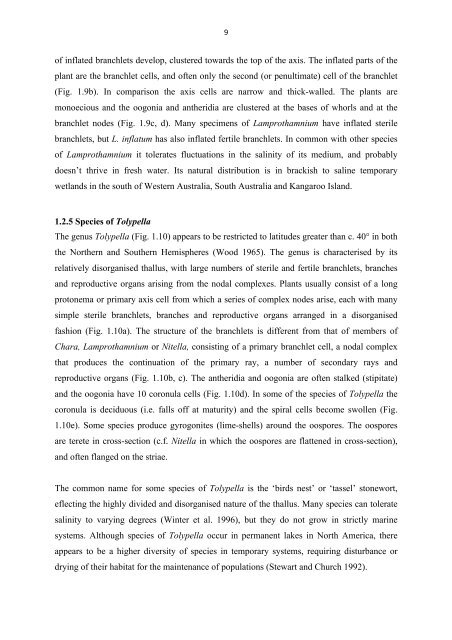Chapter 1: The Characeae Plant
Chapter 1: The Characeae Plant
Chapter 1: The Characeae Plant
Create successful ePaper yourself
Turn your PDF publications into a flip-book with our unique Google optimized e-Paper software.
9 <br />
of inflated branchlets develop, clustered towards the top of the axis. <strong>The</strong> inflated parts of the<br />
plant are the branchlet cells, and often only the second (or penultimate) cell of the branchlet<br />
(Fig. 1.9b). In comparison the axis cells are narrow and thick-walled. <strong>The</strong> plants are<br />
monoecious and the oogonia and antheridia are clustered at the bases of whorls and at the<br />
branchlet nodes (Fig. 1.9c, d). Many specimens of Lamprothamnium have inflated sterile<br />
branchlets, but L. inflatum has also inflated fertile branchlets. In common with other species<br />
of Lamprothamnium it tolerates fluctuations in the salinity of its medium, and probably<br />
doesn’t thrive in fresh water. Its natural distribution is in brackish to saline temporary<br />
wetlands in the south of Western Australia, South Australia and Kangaroo Island.<br />
1.2.5 Species of Tolypella<br />
<strong>The</strong> genus Tolypella (Fig. 1.10) appears to be restricted to latitudes greater than c. 40° in both<br />
the Northern and Southern Hemispheres (Wood 1965). <strong>The</strong> genus is characterised by its<br />
relatively disorganised thallus, with large numbers of sterile and fertile branchlets, branches<br />
and reproductive organs arising from the nodal complexes. <strong>Plant</strong>s usually consist of a long<br />
protonema or primary axis cell from which a series of complex nodes arise, each with many<br />
simple sterile branchlets, branches and reproductive organs arranged in a disorganised<br />
fashion (Fig. 1.10a). <strong>The</strong> structure of the branchlets is different from that of members of<br />
Chara, Lamprothamnium or Nitella, consisting of a primary branchlet cell, a nodal complex<br />
that produces the continuation of the primary ray, a number of secondary rays and<br />
reproductive organs (Fig. 1.10b, c). <strong>The</strong> antheridia and oogonia are often stalked (stipitate)<br />
and the oogonia have 10 coronula cells (Fig. 1.10d). In some of the species of Tolypella the<br />
coronula is deciduous (i.e. falls off at maturity) and the spiral cells become swollen (Fig.<br />
1.10e). Some species produce gyrogonites (lime-shells) around the oospores. <strong>The</strong> oospores<br />
are terete in cross-section (c.f. Nitella in which the oospores are flattened in cross-section),<br />
and often flanged on the striae.<br />
<strong>The</strong> common name for some species of Tolypella is the ‘birds nest’ or ‘tassel’ stonewort,<br />
eflecting the highly divided and disorganised nature of the thallus. Many species can tolerate<br />
salinity to varying degrees (Winter et al. 1996), but they do not grow in strictly marine<br />
systems. Although species of Tolypella occur in permanent lakes in North America, there<br />
appears to be a higher diversity of species in temporary systems, requiring disturbance or<br />
drying of their habitat for the maintenance of populations (Stewart and Church 1992).
















